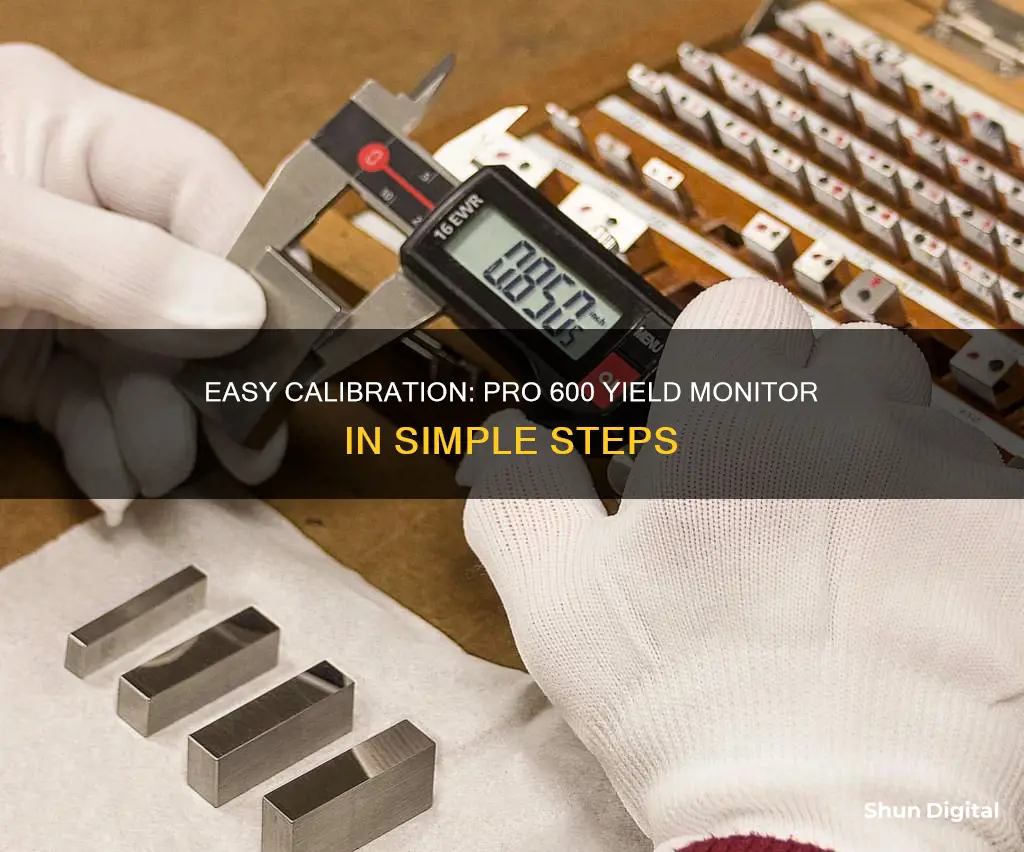
Calibrating a Pro 600 yield monitor is a crucial step in ensuring accurate yield data, which is essential for making informed decisions during harvesting operations. Proper calibration ensures that the yield monitor provides consistent and reliable data, enabling farmers to optimize their crop management strategies. While the process may seem complex, understanding the specific requirements of the Pro 600 yield monitor and following manufacturer guidelines can simplify the task. This introduction will provide an overview of the key considerations and steps involved in calibrating a Pro 600 yield monitor, helping users achieve accurate yield data for their operations.
| Characteristics | Values |
|---|---|
| Calibration Process | Single-point or Multi-point |
| Calibration Steps | Harvest a calibration load, weigh it, and enter the weight into the yield monitor display |
| Scale System | Required to get a "ground truth" load weight |
| Multi-point Calibration | Requires different crop flow rates |
| Recalibration | Required when crop moisture changes |
| Calibration Loads | 3,000 to 6,000 lbs for multi-point, up to a full grain tank for single-point |
| Calibration Speed | 2, 3, 4, and 5 mph |
What You'll Learn

The importance of calibration
Calibration is important to ensure that your yield monitor is providing accurate data. When heading into the field for harvest, it is crucial to make sure your monitors, sensors, and scales are giving you precise numbers. Taking the time to properly calibrate your yield monitor is essential for making informed decisions about your operations, as it ensures that you are working with high-quality yield data.
A well-calibrated yield monitor helps you generate reliable yield maps, which are valuable tools for post-harvest analyses and supporting crop management decisions. Calibration ensures that your yield monitor accurately calculates the yield, taking into account fluctuations in mass flow rate. This is particularly important when harvesting crops like corn, where yield monitors are sensitive to changes in grain moisture content.
Additionally, proper calibration allows you to address questions around profitability and quantify field results accurately. It also enables you to make data-driven decisions about your crop management, such as quantifying field results and addressing profitability concerns. Calibration ensures that your yield monitor is correctly interpreting the data it collects, providing you with precise information about your harvest.
The calibration process typically involves three steps: harvesting a calibration load, weighing the load to obtain a ground truth weight, and entering this weight into the yield monitor display. This process may vary depending on the specific model of your yield monitor, so it is important to refer to the manufacturer's guidelines and instructions.
By calibrating your yield monitor, you can be confident in the accuracy of your data and make informed decisions to optimise your harvest operations and crop management strategies.
Monitoring Application Pool Performance: Key Metrics and Methods
You may want to see also

Single vs multipoint calibration
Calibration is essential to ensure your Pro 600 Yield Monitor is providing accurate data. Most yield monitoring systems require either a single or multipoint calibration, and it is important to know which type your monitor needs.
Single-point calibration is a straightforward process that requires harvesting a single calibration load, which can be up to a full grain tank in size. This load is then weighed on a grain cart or truck to obtain a "ground truth" weight, which is then entered into the yield monitor display. While this method is simple, it may not provide the level of accuracy required for precise decision-making.
Multipoint calibration, on the other hand, offers a more comprehensive approach. It involves harvesting multiple calibration loads at different crop flow rates, typically between 3,000 to 6,000 lbs each. Each load is weighed, and the weights are entered into the yield monitor display. By calibrating at multiple flow rates, you can ensure that the yield monitor accurately calculates yield, even when the actual flow rate fluctuates due to changes in crop yield. This is especially important when harvesting at high and low rates, as the Pro 600 Yield Monitor tends to read low at high rates and high at low rates.
To perform a multipoint calibration, start by harvesting several calibration loads at your normal operating speed, such as 4 mph. Then, capture additional calibration loads at slower and faster ground speeds, such as 2, 3, and 5 mph. This process manually fluctuates the flow rate and helps ensure accuracy throughout the calibration curve.
While single-point calibration is more straightforward, multipoint calibration provides a more accurate representation of yield data by accounting for fluctuations in mass flow rate. It is important to refer to the manufacturer's guidelines to determine the specific calibration requirements for your Pro 600 Yield Monitor and follow the recommended calibration process.
Syncing Wacom Pen Tips: Monitor Size Matters
You may want to see also

Steps to calibrate
Calibrating your Pro 600 yield monitor is a straightforward process, but it's important to be thorough to ensure you're getting accurate data readings. Here is a step-by-step guide on how to calibrate your Pro 600 yield monitor:
Step 1: Understand Your Yield Monitor
First, familiarize yourself with your Pro 600 yield monitor and its components. Refer to the information provided by the manufacturer, such as user manuals, online guides, and training sessions. Understanding how your yield monitor works is essential for effective calibration.
Step 2: Consult the Manufacturer's Guidelines
Different yield monitors have different calibration requirements. Check the manufacturer's guidelines to determine if your yield monitor needs a single-point or multi-point calibration. This step is crucial, as it will impact the subsequent steps.
Step 3: Prepare for Calibration
Before heading into the field, ensure that your yield monitor, sensors, and scales are all functioning correctly. Check for any wear, tear, or damage, and make sure all connections are tight. Additionally, verify that your scale system is accurate to prevent introducing errors into your yield data.
Step 4: Harvest a Calibration Load
The next step is to harvest a calibration load. If you're performing a multi-point calibration, the load should typically be between 3,000 to 6,000 lbs. For single-point calibration, you can go up to a full grain tank. Maintain a consistent ground speed during this process.
Step 5: Weigh the Calibration Load
Weigh the calibration load you've harvested. You can use a grain cart, seed buggies with scales, or truckload scale tickets from an elevator. Getting an accurate weight for the load is essential for the calibration process.
Step 6: Enter the Weight into the Yield Monitor
Once you have the ground truth weight, input this value into the yield monitor display. Repeat this process for multi-point calibrations, using different crop flow rates. For example, collect calibration loads at varying speeds such as 2, 3, 4, and 5 mph to ensure multiple points throughout the calibration curve.
Step 7: Recalibrate as Needed
Recalibration is necessary when crop conditions change, especially when there are changes in grain moisture. Recalibrate your yield monitor throughout the harvest season to maintain accuracy. Additionally, inspect the mechanical components periodically for any buildup or obstructions.
Monitor Measurements: Know Your Screen's Dimensions
You may want to see also

Scale accuracy
To ensure accurate yield data, it is essential to verify the accuracy of your scale system when collecting ground truth load weights for calibrating your Pro 600 yield monitor. Introducing errors into your yield data can occur if your scale system is inaccurate.
There are various methods to obtain a "ground truth" load weight, including:
- Using seed buggies with scales.
- Employing grain carts with scales.
- Obtaining truckload scale tickets from an elevator.
When using a grain cart to calibrate your yield monitor, it is advisable to keep the grain cart half-full when collecting ground truth weights. This practice ensures that the weight range on the grain cart scales aligns with the full cart weight values validated against elevator tickets.
Additionally, it is crucial to distinguish between single-point and multi-point calibration requirements for your yield monitor. For multi-point calibrations, the calibration loads should typically range between 3,000 and 6,000 lbs. On the other hand, single-point calibrations can accommodate larger loads, even up to a full grain tank.
To ensure the accuracy of your grain cart scales, it is recommended to verify them against truck load net weights from elevator scale tickets. This practice ensures consistency throughout the season.
Creative Ways to Reuse Old LCD Monitors
You may want to see also

Recalibration
It is important to recalibrate your yield monitor throughout the harvest season as crop conditions change. Changes in grain moisture can affect the accuracy of the calibration, and as your crop continues to dry down later in the season, the yield monitor’s sensor will react differently. Yield monitors for corn are particularly sensitive to moisture changes. Corn harvested above 20% moisture will require recalibration every 2.5% change in moisture to maintain a yield monitor error of less than 5%.
When recalibrating, pay close attention to the mechanical components of the grain handling and yield monitor system. Regularly inspect the sensor for dirt buildup or other debris obstructing it. Also, check for proper tension on the combine’s clean grain elevator chain, as this is critical in maintaining consistent yield monitor accuracy. If you replace the clean grain elevator chain, this will often require a new yield monitor calibration to be completed.
It is also important to check your scale system for accuracy. There are many ways to get a “ground truth” load weight, including using seed buggies with scales, grain carts with scales, or truckload scale tickets from an elevator. When collecting ground truth load weights for your yield monitor calibration, it is important to verify that the scale system you are using is accurate, or you could be introducing more error into your yield data.
To recalibrate, follow the typical calibration process:
- Harvest a calibration load. For multi-point calibrations, these loads should be between 3,000 to 6,000 lbs. For single-point calibrations, these loads can be larger, up to a full grain tank.
- Weigh the calibration load on a grain cart or truck to get a ground truth weight for the load.
- Enter the ground truth weight into the yield monitor display.
Repeat this process for multi-point calibrations using different crop flow rates.
Mounting Your Ultrawide: A Step-by-Step Guide for ASUS Monitors
You may want to see also







